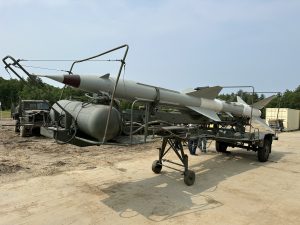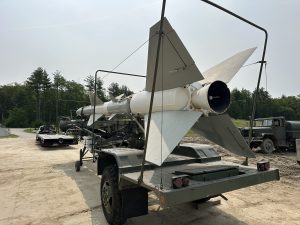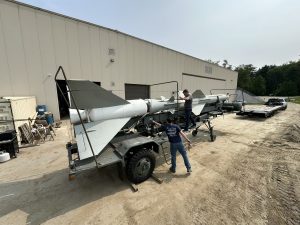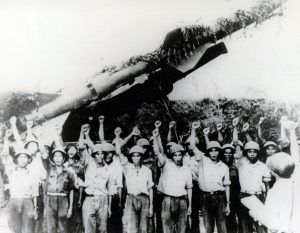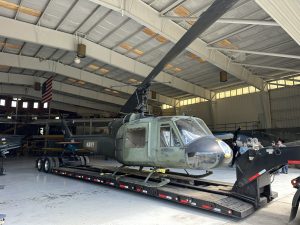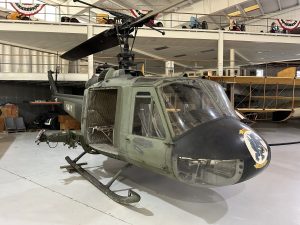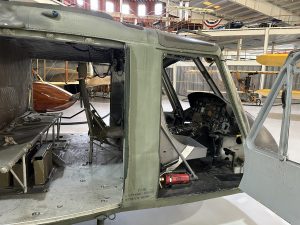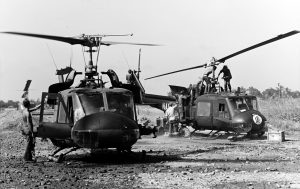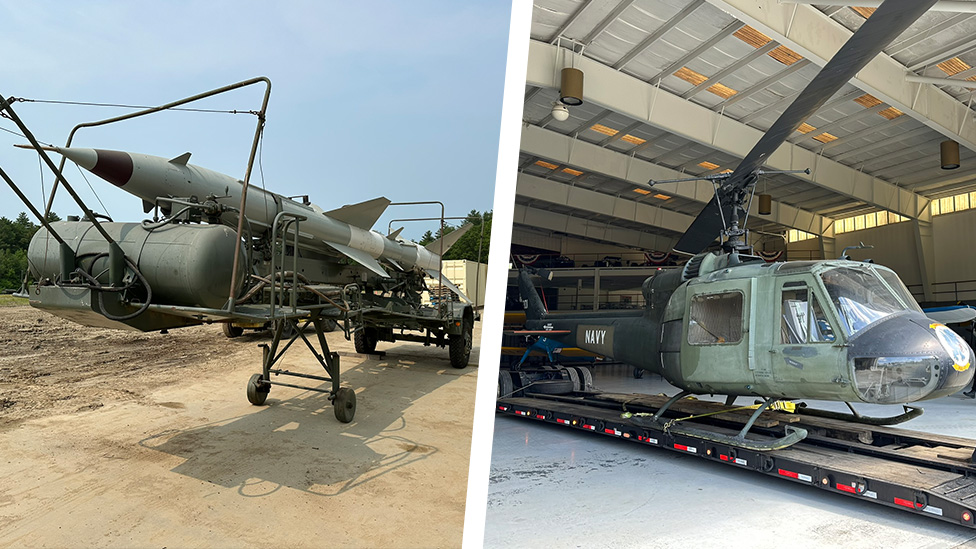
The American Heritage Museum’s Vietnam War Gallery will be expanding with two significant new additions over the coming year: an SA-2 Guideline surface-to-air missile (SAM) and Bell HH-1K “Huey” representing the U.S. Navy’s HA(L)-3 (Helicopter Attack Squadron Light) “Seawolves”. These two major artifacts are now on-site and are being prepared for installation and display by the museum restoration staff and volunteers.
SA-2 Guideline
The SA-2 Guideline Missile arrived at the AHM on June 4th and is on long-term loan from the National Museum of the U.S. Air Force (NMUSAF) in Dayton, OH. This iconic Cold War-era weapon will be displayed alongside the F-105G Thunderchief “Wild Weasel”, also on loan from the NMUSAF, creating a powerful narrative about the deadly cat-and-mouse game of aerial warfare over North Vietnam.
Developed in the mid-1950s, the Soviet-designed V-750 Dvina—better known by its NATO designation SA-2 Guideline—was the first effective surface-to-air missile (SAM) system of its kind. It entered the global spotlight during the Cold War when Soviet forces used it to shoot down U.S. reconnaissance aircraft, including Gary Powers’ U-2 over the Soviet Union in 1960 and Maj. Rudolph Anderson’s U-2 over Cuba during the 1962 Missile Crisis. Beginning in 1960, the Soviet Union exported SA-2s to allied nations worldwide, and many remained in service well into the 21st century.
North Vietnam began receiving SA-2 systems in 1965 during the opening stages of Operation Rolling Thunder, the U.S. Air Force’s sustained bombing campaign. With Soviet advisors, the North Vietnamese established a network of mobile and well-camouflaged SAM sites, each armed with six missiles and supported by control vans, acquisition radars, and Fan Song guidance radars. These sites were often protected by rings of anti-aircraft artillery, making them formidable threats to American pilots.
The SA-2 missile was a two-stage weapon, using a solid-fuel booster for launch followed by a liquid-fuel rocket to reach speeds of Mach 3.5. It could engage targets up to 60,000 feet and 19 miles away, carrying a devastating 288-pound blast-fragmentation warhead. Once launched, the missile was guided to its target by the Fan Song radar, which could track multiple aircraft simultaneously.
This evolving threat spurred the creation of specialized U.S. Air Force units: the “Wild Weasels.” Flying aircraft like the F-105G Thunderchief, these pilots pioneered the risky mission of locating and destroying enemy radar and SAM sites before they could endanger strike packages. The Wild Weasels revolutionized electronic warfare, often engaging SA-2 sites within hours of their deployment—countering the North Vietnamese tactic of packing up and moving sites within four hours to avoid destruction.
By displaying the SA-2 Guideline and the F-105G together, the American Heritage Museum vividly illustrates the technological duel between Soviet air defense systems employed by North Vietnam and dramatic American suppression tactics during the Vietnam War to diminish its threat. The SA-2 is currently being cosmetically restored and prepared for display by the AHM Restoration Team for installation in the museum later this year.
Bell HH-1K Iroquois “Huey”
The American Heritage Museum’s Vietnam War Gallery will grow even further with the arrival of an iconic helicopter design that came to define the Vietnam War for many: the Bell HH-1K Iroquois, better known as the “Huey.” On long-term loan from the National Naval Aviation Museum in Pensacola, Florida, this storied helicopter arrived at the AHM on July 1st and, once on display, will add a new dimension to the museum’s exploration of air power and innovation during the Vietnam War.
The “Huey” was born from necessity and became a symbol of adaptability and resilience. Its lineage began with the maiden flight of the original Iroquois design on October 20, 1956. Initially designated HU-1 by the U.S. Army, its radio call sign gave rise to the enduring nickname “Huey,” a name that stuck even after the aircraft’s designation changed to UH-1. Few would ever call it by its official name.
Though the early Hueys were not particularly fast—with a cruise speed around 115 mph—they excelled in versatility. Their box-like fuselage could lift troops into combat zones, hover in tight spaces for medevac operations, and serve as a platform for heavily armed gunship variants. Between 1965 and 1969 alone, Army, Navy, and Marine Corps Hueys evacuated an estimated 378,000 wounded personnel from the battlefields of Vietnam, saving countless lives.
The Huey adapted to the needs of every U.S. military branch. In Naval Aviation, the helicopter entered service with the Marine Corps as the UH-1E in 1964. The Navy followed with the HH-1K and TH-1L variants, which were tailored for search and rescue and training duties, respectively. Later models like the twin-engine UH-1N extended the Huey’s service life into conflicts from Desert Storm to Iraqi Freedom, and even into polar exploration with Operation Deep Freeze in Antarctica.
In 1967, the Navy stood up Helicopter Attack Squadron Light (HA(L)) 3—nicknamed the “Seawolves.” These squadrons, flying Hueys outfitted with machine guns, rockets, miniguns, and even grenade launchers, provided close air support for riverine patrols and special operations forces in the Mekong Delta. Their crews were legendary for their courage and responsiveness, logging tens of thousands of flight hours under hostile fire.
The museum’s own HH-1K (Bureau Number 157188) flew with HA(L)-5, a Naval Air Reserve squadron formed at NAS Point Mugu, California. In this role, it supported special operations missions, including the insertion and extraction of Navy SEAL teams. This aircraft even carries scars from its service—damage sustained during an airborne firing exercise off San Clemente Island.
Currently, the HH-1K will be stored in the aircraft hangar annex as it is cosmetically prepared for display and installation in the museum over the North Vietnamese PT-76 amphibious tank later this year. During this preparation period, the HH-1K will be on display only during special event weekends through October.
Once added to the Vietnam War Gallery, HH-1K will offer visitors an opportunity to reflect on the remarkable impact of this humble yet heroic machine. Together with other aircraft and artifacts from the era, the “Huey” helps tell the story of a conflict where air mobility and innovation shaped every battle—and where helicopters like this became lifelines for soldiers on the ground.

